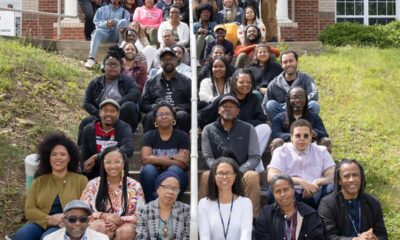Health & Wellness
National Medical Association President Dr. Yolanda Lawson Speaks Out on GYN Healthcare Crisis Facing Black Women

By Fern Gillespie
There is a GYN healthcare crisis facing Black women in the U.S. Black women have higher rates of uterine cancer, infant mortality, and pregnancy-related deaths than their white female counterparts.
Since 1895, the National Medical Association, currently comprised of over 50,000 Black American physicians, has been at the forefront for parity and justice in medicine and the elimination of disparities in health issues related to African Americans and medically underserved populations.
Yolanda Lawson M.D, Board Certified OBGYN, is the 124th President of the National Medical Association. Based in Dallas, she serves as a medical director for a community-based organization that addresses HIV treatment and prevention disparities in target communities. Dr. Lawson, nationally recognized for her commitment as a women’s health advocate, is the founder of MadeWell Obstetrics and Gynecology, which specializes in superior, organic healthcare with diplomacy, concern, and respect for her patients. She earned her medical degree at the University of Arkansas for Medical Sciences and interned at Morehouse School of Medicine in Atlanta. Dr. Lawson completed her residency at St. John Hospital & Medical Center in Detroit and is currently an associate attending at Baylor University Medical Center. Our Time Press spoke with Dr. Lawson about her insights on the GYN healthcare crises facing Black women.
OTP: The CDC says Black women are three times more likely to die from pregnancy than White women. What do you tell your patients during their pregnancy?
Dr. Lawson: Yes, Black women are three times more likely to die from pregnancy-related complications. Black women are more likely to have a preventable pregnancy-related death. While there is public awareness, this has caused fear and additional anxiety. I provide patients with specific information about their individual risks for pregnancy complications. An individualized approach is necessary. Secondly, education or warning signs and symptoms, and lastly reassurance. Identifying support persons, ensuring communication with their trusted OB provider and compliance with prenatal care and instructions are key to reducing risk.
What do you think can be done about the high rate of Black infant mortality?
Dr. Lawson: Black infant mortality rates are 2.35 times greater than white infant mortality. The leading causes are birth defects, preterm birth, sudden infant death syndrome, injury and maternal pregnancy complications. It is important that we look at the drivers specific to Blacks. It is widely recognized that Black women, other minority groups, and the socioeconomically disadvantaged, have the highest rates of preterm birth. According to the March of Dimes’ 2021 report, the preterm birth rate among Black women is 14.0 percent. It is 51 percent higher than the rate among all other women in the U.S. Babies born too early account for about 16 percent of infant deaths (death before 1 year of age) and those who survive have breathing problems, feeding complications, cerebral palsy, and development delays.
Why do Black women have a higher rate of uterine cancer and is early detection important?
Dr. Lawson: Black women have a higher rate of death from uterine cancer. Black women are twice as likely to die of uterine cancer as white women–while the disease is slightly more common in white women than in Black women. Some of the factors related are access to gynecologic care, awareness, and research that has not included adequate people of color. Black women with uterine cancer are also more likely to be diagnosed with more aggressive forms of uterine cancer.
What do you think about chemical hair straightening products being linked to Black women and GYN cancers?
Dr. Lawson: First women must understand the association was with uterine cancer. Uterine cancer accounts for 3 percent of all new cancer cases but is the most common cancer of the female reproductive system. Many Black women have used hair straightening. The study that was done found that 1.64 percent of women who never used hair straighteners would go on to develop uterine cancer by the age of 70. For frequent users, the risk went up to 4.05 percent. The study included over 31,000 women of which 60 percent were Black.
The Association of American Medical Colleges has said there has been an increase in the number of Black students attending medical school. What is the NMA doing to persuade more Black Americans to go into medicine and become physicians?
Dr. Lawson: The NMA and one of my presidential platforms is the Healthcare Workforce. NMA believes building the pipeline of Black doctors is a key strategy for decreasing health disparities. Only 5.7 percent of physicians in the US identify as Black or African American, whereas an estimated 12 percent of the US population is Black or African American. Black male medical school enrollment is 2.9 percent. NMA advocates for STEM funding in programs for grades K-12 and pipeline programs in Black school districts. During our National Assembly last week in New Orleans, we held “STEM Fest” in partnership with local nonprofit organization STEM NOLA and the Ochsner Medical Center in New Orleans. There were over 600 students from grades K-12 that were exposed to Black doctors, human anatomy, building mechanical lungs, dissecting hearts and lungs, demonstrating AI, and exploring the human body.













